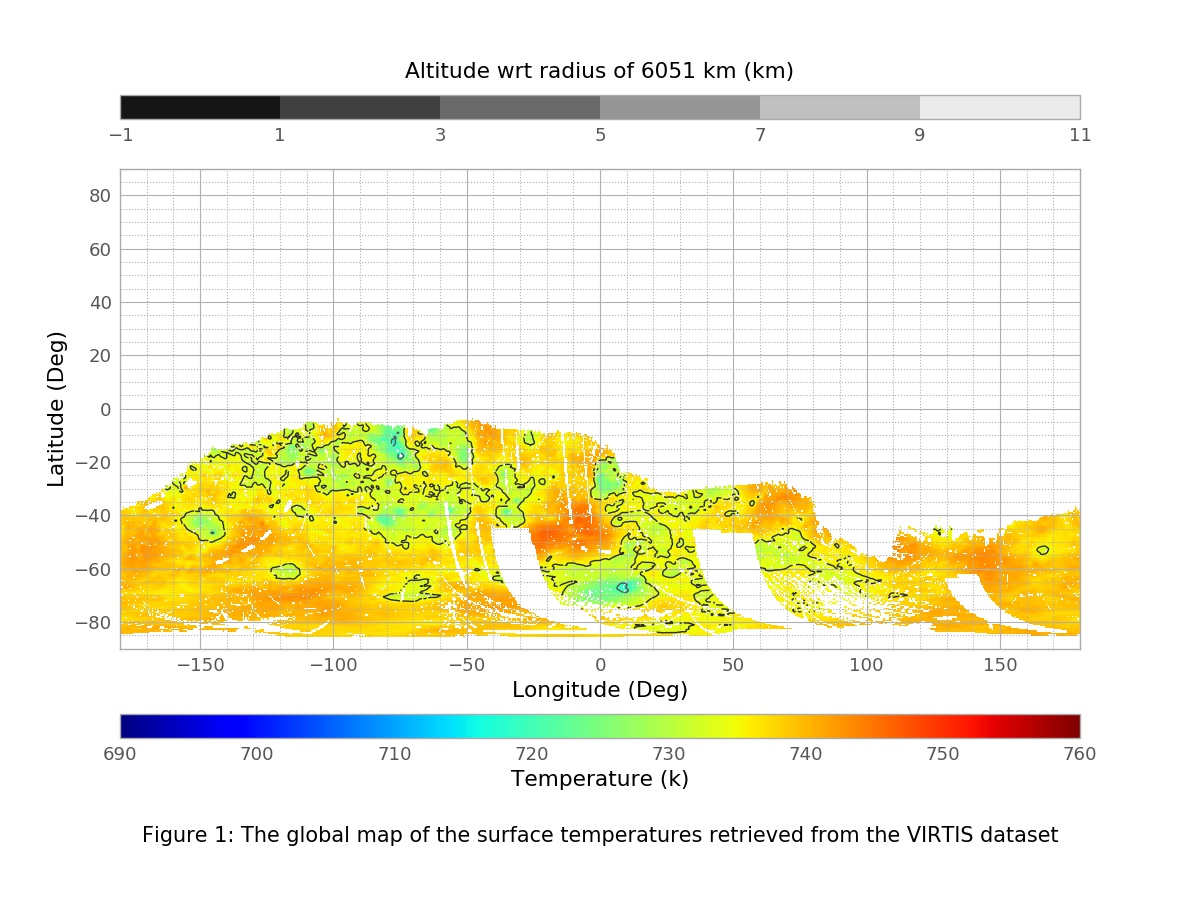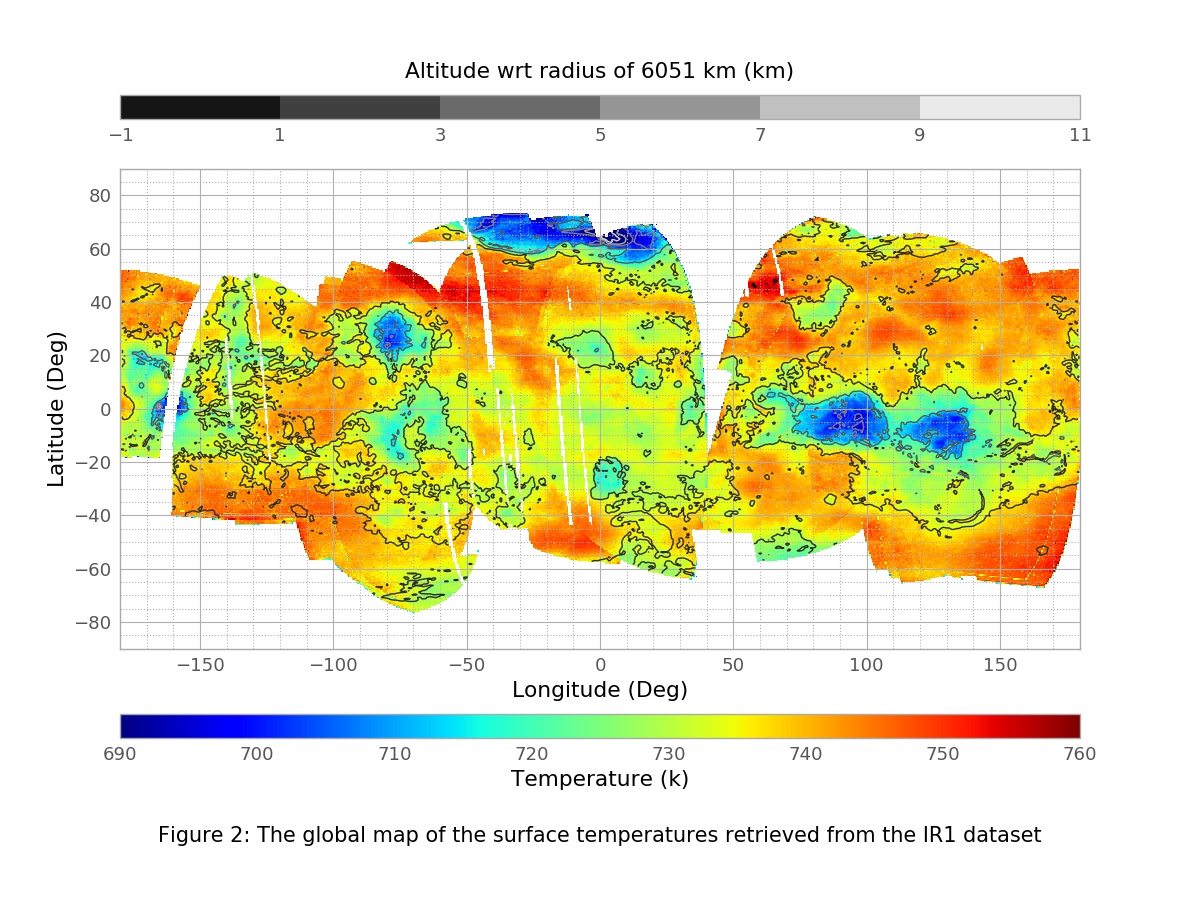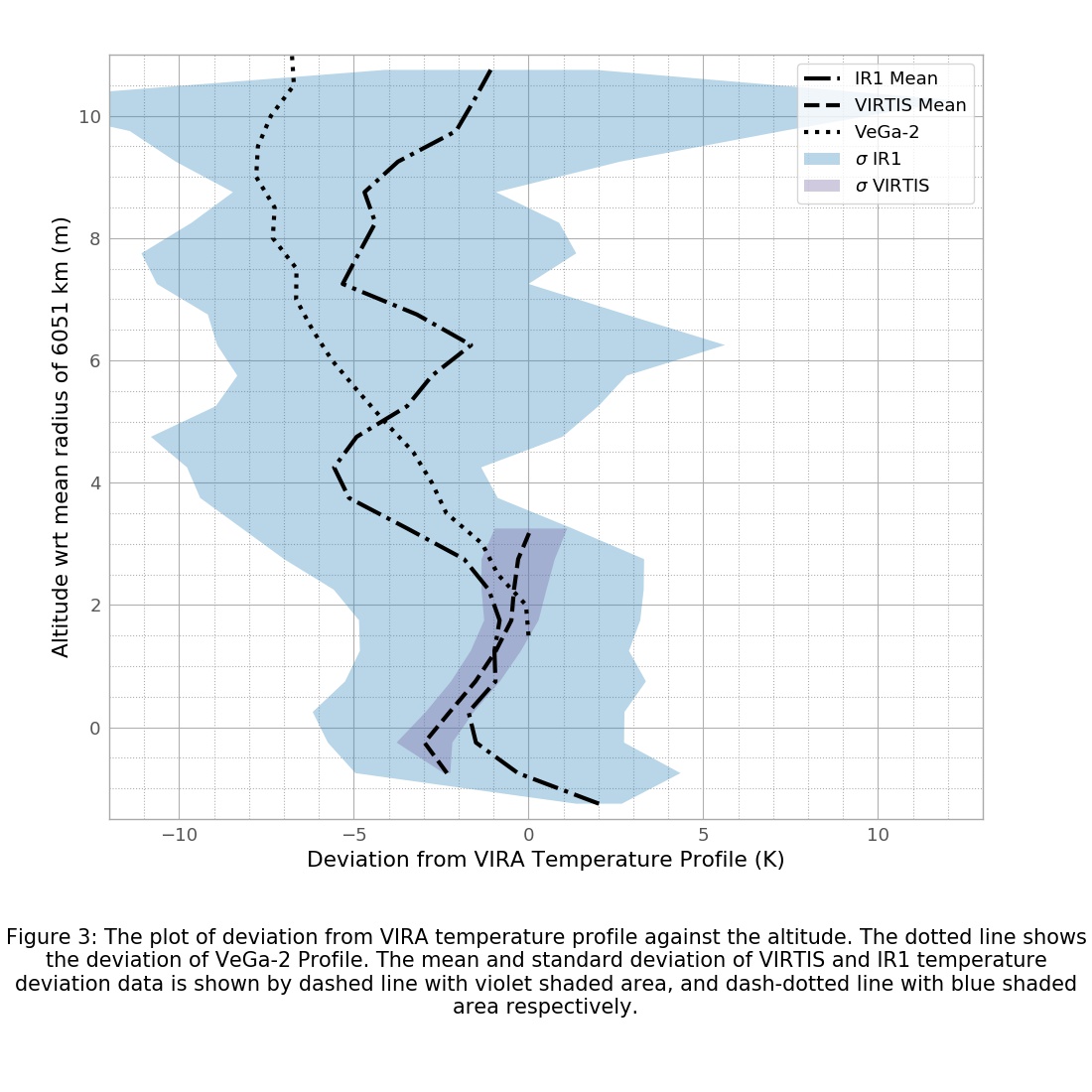Near-IR Investigation of the Thermal Structure of Venusian Deep Atmosphere
- 1Astrodynamics and Space Missions Dept, TU Delft, Delft, Netherlands
- 2Planetary Physics Dept, DLR Institute of Planetary Research, Berlin, Germany
- 3Laboratoire de Météorologie Dynamique (LMD/IPSL), Sorbonne Université, ENS, PSL Research University, Ecole Polytechnique, Institut Polytechnique de Paris, CNRS, Paris, France
Introduction: Given the extreme conditions in the lower atmosphere of Venus, various in-situ missions faced instrumental failures. As a result, the thermal structure of the deep atmosphere, particularly below 12 km is not well known. In Venus International Reference Atmosphere (VIRA), the thermal structure of the atmosphere below 12 km altitude was constructed by extrapolating the data recorded in the upper atmosphere. Only VeGa-2 lander provided the high-resolution temperature measurements below 12 km altitude. However, these measurements indicated a region of high instability below 7 km altitude. Due to a lack of physical explanation, these measurements were not included in VIRA.
Methodology: In this study, we use the previous near-IR observations of Venus nightside to investigate the thermal structure of the deep atmosphere. First, a surface temperature map is generated from the near-IR observations. By correlating this map with surface topography a surface temperature vs altitude profile is generated. Assuming that the surface is in thermal equilibrium with the atmosphere [1], the surface temperature vs altitude profile then provides the thermal structure of the deep atmosphere. In the end, we compare the retrieved thermal structure with the VIRA and VeGa-2 temperature profiles.
Data Processing: The near-IR observations from the VIRTIS instrument onboard the Venus Express and the IR1 imager onboard the Akatsuki orbiter are used in our study. The VIRTIS dataset has been already processed by [2] and contains the observations of the southern hemisphere having an altitude range below 4 km. The equatorial and northern highlands on Venus were observed by the IR1 imager. However, the IR1 observations are heavily contaminated by the bright straylight coming from the dayside of Venus. Also, the calibration had an uncertainty of±67%. To make use of the IR1data, we develop a correction procedure that includes (1) starylight correction, (2) limb darkening correction, and (3) cross-calibration using the VIRTIS data.
Radiative Transfer: To retrieve the surface temperatures from the near-IR observations, we develop an atmospheric radiative transfer model based on the radiative transfer code from [3]. The atmosphere is constructed by using VIRA profiles. We use the cloud model from [4] and Mie scattering is treated by using the code from [5]. We model the absorption using the line-by-line code from [6] and considering eight major absorbing species. Appropriate spectral line dataset and lineshapes are used. To simulate the effect of topography on Venus, we generate the results in the form of a look-up table in which we vary the starting altitude of the atmosphere from -3 to 13 km altitude with respect to a 6051 km planetary radius. We validate our model based on the results generated by the model described in [7].
Results and Conclusion: The coverage of the VIRTIS and IR1 datasets can be observed from the maps of retrieved surface temperatures shown in Figure 1 and Figure 2. Figure 3 shows the trendlines of mean values of the deviation of surface temperature with respect to VIRA temperature profile against the altitude for both the dataset. The dotted line shows the deviation of the VeGa-2 profile.
We find that the VIRTIS and IR1 temperature trendlines show a lapse rate lower than VIRA from 0 to 1.5 km altitude, as previously indicated by [8]. Above this altitude VIRTIS trendline follows the VIRA lapse rate, however, the observations are limited up to an altitude of 3.5 km.
Above 2 km altitude, the IR1 temperatures fall even faster than the VeGa-2 profile and achieve a maximum deviation of∼5 K from the VIRA profile between 4-5 km and 7-8 km altitude range. This indicates that the situation could be even more complex than indicated by the VeGa-2 profile. Above 8 km altitude, the IR1 data is less reliable. The reasons behind the differences in the IR1, and VIRA profiles are not clear. Possible reasons could be surface emissivity variations, a near-surface layer of aerosols, or a composition gradient [9].
Thus, we find that both the VIRTIS and IR1 profile do not completely agree with either VIRA or VeGa-2 profile. However, observations from both VIRTIS and IR1 instruments were not ideal for the surface-emission studies. An optimized instrument could provide better coverage and quality of the data which could significantly help near-surface studies. Based on this, we highlight the need for future near-IR observations with an instrument optimized for the surface observing atmospheric windows of Venus.



References:
[1] Lecacheux, J., Drossart, P., Laques, P., Deladerriére, F., and Colas, F., Planetary and Space Science 41(7), 543–549 (1993).
[2] Mueller, N., Helbert, J., Hashimoto, G. L., Tsang, C. C., Erard, S., Piccioni, G., and Drossart, P., Journal of GeophysicalResearch E: Planets 114(5), 1–21 (2009).
[3] Wauben, W. M. F., De Haan, J., and Hovenier, J., Astronomy and Astrophysics -Berlin-282(1), 277–277 (1994).
[4] Barstow, J. K., Tsang, C. C., Wilson, C. F., Irwin, P. G., Taylor, F. W., McGouldrick, K., Drossart, P., Piccioni, G., andTellmann, S., Icarus 217(2), 542–560 (2012).
[5] De Rooij, W. and Stap, Van Der, C., Astronomy and astrophysics (Berlin. Print) 131(2), 237–248 (1984).
[6] Stam, D. M., De Haan, J. F., Hovenier, J. W., and Stammes, P., Journal of Quantitative Spectroscopy and RadiativeTransfer 64(2), 131–149 (2000).
[7] Tsang, C. C., Irwin, P. G., Taylor, F. W., and Wilson, C. F., Journal of Quantitative Spectroscopy and Radiative Transfer 109(6), 1118–1135 (2008).
[8] Meadows, V. S. and Crisp, D., Journal of Geophysical Research: Planets 101(E2), 4595–4622 (1996).
[9] Lebonnois, S. and Schubert, G., Nature Geoscience 10(7), 473–477 (2017).
How to cite: Kulkarni, S., Mueller, N., Stam, D., and Lebonnois, S.: Near-IR Investigation of the Thermal Structure of Venusian Deep Atmosphere, European Planetary Science Congress 2021, online, 13–24 Sep 2021, EPSC2021-730, https://doi.org/10.5194/epsc2021-730, 2021.

